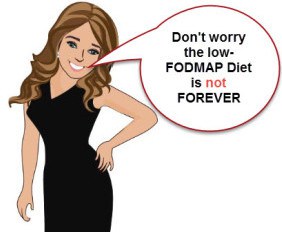“What? So I’m not going to be able to eat bread, garlic and apples ever again?” Not necessarily, in fact the good news is that the low FODMAP diet is not for life, at least not in its most extreme form. It is actually recommended that one doesn’t stay on a strict low FODMAP diet for an extended period of time; it can put you at risk of depleted stores of certain nutrients and beneficial gut bacteria. Similar to many other therapeutic diets, there are phases to follow- 1) The Elimination Phase, 2) The Reintroduction Phase, and 3) Maintenance.
As already described on a different post, the low FODMAP Diet consists of three phases:
Low FODMAP Diet Phases (Elimination – Reintroduction – Maintenance)
Elimination Phase
This phase usually lasts up to 6 weeks (this is individual, your health professional will work out how long you will need to continue this phase) in which time a person should follow a diet, strictly eliminating all FODMAP foods. It is useful to monitor and record symptoms and food intake in a diary. This record will help you track any benefits from the dietary program or serve as an informative tool to show your health professional, if symptoms persist beyond the 6 weeks of strict elimination.
It is helpful to become very familiar with foods containing FODMAPs; download the Monash University app for smartphone and consult it when you visit the grocery store and plan your meals and snacks. Everyone is different but symptoms should decrease after a week or so of following the strict diet.
Reintroduction Phase
After the 6 weeks of the elimination phase and when symptoms have all but completely eased, the reintroduction phase can commence. The goal of this phase is to systematically reintroduce each group of FODMAPs (oligosaccharides/wheat, disaccharides/lactose, monosaccharides/fructose/honey, etc.) back into the diet to determine how much of an individual FODMAP you can comfortably tolerate. This phase is important as it helps you develop an individualised eating plan that will optimise health and variety.
This phase usually lasts 5-8 weeks where each week, a different carbohydrate is trialled. The FODMAP-containing food is consumed 3 days of the week, with FODMAP-free days in-between to monitor symptoms and record (in your “special” diary). A sample of this systematic reintroduction phase can been seen in my other post where I talk about the phases of the low FODMAP diet.
During this period, it is recommended that all FODMAPs be avoided other than the ones that are being tested that week, even if your guts seem to be handling certain foods alright. This is to make sure you get a more accurate picture of the effects of the current FODMAP class being tested.
The Maintenance Phase
Well Tolerated FODMAPs
At the end of the 5 week re-introduction phase, it is a good idea to take a week to trial all the well-tolerated FODMAP groups to determine if you can handle consuming them all together as part of your diet. It is recommended that you don’t go crazy with serving sizes of these re-introduced foods and keep a close eye on any recurring symptoms. If any symptoms do return then it might be best to eliminate these groups until symptoms subside then include them again at a lower dose. Everyone is different and there’s a bit of trial and error involved in determining what is “too much” of a certain FODMAP group for you but you will figure it out.
Not Tolerated FODMAPs
If certain FODMAP intolerances were observed during the re-introduction phase, it is recommended to avoid or greatly restrict those symptom-inducing foods in your day-to-day diet.
Does the low FODMAP diet reduce beneficial gut bacteria?
Upon your low FODMAP journey, you will come across research that highlights the effect such a diet might have on your gut bacteria. Many of the high fibre FODMAP foods are prebiotics, stimulants of growth/activity of good bacteria in the large intestines. So naturally, a low FODMAP diet will reduce the intake of these prebiotics which may impact the growth of certain bacteria in the gut. For this reason, it is not a great idea to follow a strict low FODMAP diet unnecessarily. This also highlights the importance of the re-introduction phase.
References:
http://www.med.monash.edu.au/cecs/gastro/prebiotic/faq/#9
http://www.ncbi.nlm.nih.gov/pmc/articles/PMC3736783/



Thank you
Thanks Larah another great post!